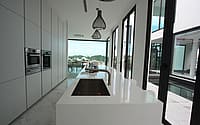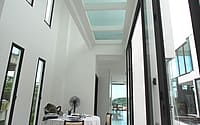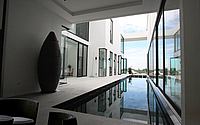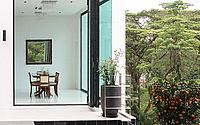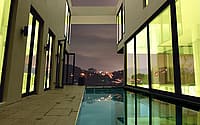The Skywalker House by S.PIN Architect
The Skywalker House is a modern house located in Kuala Lumpur, Malaysia, designed in 2012 by S.PIN Architect.







Description
THE SITE & BRIEF
The Skywalker House is a house design prototype that ‘skywalks’ on a 42-degree slope, minimizing footprint & complementing the surrounding green at the same time, proofing the viability of the co-existence between nature and architecture.
The house, for a medium-size family, is located at Bangsar, a hilly posh suburb near Kuala Lumpur, Malaysia. The site is at the least developed section of the suburb surrounded by green. The brief called for a 3-level modern house that has to sit comfortably on a steep 0.2-acre site overlooking the surrounding urban skyline. The only access is from the slope toe, 19 meters lower than the rear boundary. The gentle profile at the hilltop is only 15% of the site area. This has prompted the architect to seek a new prototype design for this challenging condition.
CONCEPT
Taking advantage of Malaysia’s rich multi-racial heritage (Malay, Chinese & others), the architect drew inspiration from the local ethnics’ vernacular architecture to address the design challenges. One of them is borrowing ideas from the Malay vernacular architecture to lift this modern house off the ground to minimize the impact on the terrain & trees. 30% of it has also been cantilevered to minimize the stilts intrusion, with only a retaining wall at the slope toe to the house car park.
SPACE PROGRAMME
One makes a dramatic arrival at the elevated entrance porch at Level 2 via an 18-meter high translucent lift shaft from the car park at the slope toe. When ascending to the entrance level, the outdoor glass jacuzzi greets one midway thru, heightens one’s anticipation of what to come next. In the end, the lift door opens to a panoramic skyline on one side & an elevated pool courtyard on the other side.
The common spaces are concentrated at Level 2 with the elevated pool courtyard as the central feature. All these indoor spaces are interwoven with semi-enclosed family social spaces.
FORM, ELEVATED COURTYARD & WIND CHANNEL
The house’s basic geometric form enables an efficient floor plan. It helps to save enough space to enable the ‘missing’ flat garden land to be brought up to the elevated building via an elevated pool courtyard.
The form also enables efficient structure design and helps to cut the steel & concrete usage.
Deriving idea from local old Straits Chinese courtyard home, the linear courtyard was designed to form wind channel punching thru patio and out at the rear garden. The Binnoli Effect of narrowing wind path increases the wind velocity when the house captures the high-level wind from the front. The pool water cools down the wind channels through the narrow courtyard,
creating cooling micro-climate in and around the house despite under the tropical sun.
The breath-taking cantilevered infinity pool at the elevated courtyard overlooks Petaling Jaya skyline.
CLIMATIC DESIGN
The building faces south with the front façade projected concrete frame shades the glass facade. The side windows that face east-west are kept minimal. Most large openings face inwards towards an elevated courtyard.
CAISSON FOUNDATION & REDUCED USE OF CONCRETE
The core of the building is a reinforced concrete frame. Caisson foundation system which only involves manual casting was adopted. This is to avoid flattening the slope to mobilize pile rigs.
The absence of extensive retaining walls to support the earth & building has substantially reduced the use of concrete.
EXPERIMENTAL PASSIVE VENTILATION DESIGN
1. Ventilation pits on the wall for ceiling ventilation creates a cool air pocket in the ceiling space. The idea was derived from ‘Hong Kang’ (Wind Hole), ventilation openings above windows found in local traditional Straits Chinese homes that vents out warm air at a high level
2. Louvre Wall & Skylight: The traditional local Malay house shutter window with louvers was remodeled and romanticized into extensive louver wall to create a unique breezy but still private shower environment at top floor
3. Inspired by the traditional Straits Chinese house air well, the bath suite of this house opens to a mini courtyard, a design that encourages warm and cool air exchange
PERFORMANCE IN USE
1. The elevated structure gets fresher air compared to the typical landed houses. The air is cooler at night and the family sleeps with an open window without operating an air-conditioner or fan. This is rare in this highly urbanized area where everyone lives in air-conditioned building capsules.
2. The wind channel microclimate effect, the deeply shaded elevated courtyard, water-cooled semi-enclosed space around the courtyard enable the family:
a. to hang out around the courtyard outdoor even at noon.
b. to be in the living, dining & kitchen without air-conditioner.
c. enjoys extensive natural light without direct heat gain due to the deep verandah.
3. The full louver walls keep the kitchen & bathroom running with zero mechanical ventilation system thus far.
4. Item 1, 2 &3 above together with the low E glass installed save 30% of the supposed electricity consumption.
5. The elevated structure consumes 30% less steel & concrete than its neighboring lot houses on similar site conditions but with conventional retaining walls.
6. The rainwater tank has helped to reduce the piped water consumption for irrigation by about 10% of the supposed piped water consumption
SOCIAL SPACE
The courtyard become the family’s popular hangout space in the evening due to the sense of conducive space created by the courtyard.
PROJECT SIGNIFICANCE
Taking advantage of Malaysia’s rich multi-racial heritage, the architect drew inspiration from the local ethnics’ vernacular architecture to address the challenges posed by the site and by the warm & humid tropical weather via modern language:
1. Borrowing an environmental-friendly strategy from the Malay vernacular architecture with houses on stilts, the project explored a new prototype for Malaysian houses on slope. It may set a new development model for future buildings around the Bangsar hilly area which is currently bulldozed by houses’ extensive retaining walls and ramps (refer to current Bangsar pics below). Like the Malay house, the on-stilts feature provides additional privacy and security.
2. Translating ideas from local traditional Straits Chinese courtyard home, various natural ventilation inducer designs have been introduced in this house. Together with the greenery surrounding the building, these features enable a substantial part of the house to be fully naturally ventilated, a rarity in this highly urbanized area. The air at the elevated level is cooler at night and the family sleeps with open windows without operating an air-conditioner or fan.
3. Within the context of the modern suburb, traditional tropical architecture language: orientation, internal planning, ventilation & shading has been subtlely and unpretentiously incorporated in modern architecture thru this project with the aspiration to bridge the traditional architectural value and modern design language, creating a springboard for future development in Malaysia hilly area.
Photography courtesy of S.PIN Architect
Visit S.PIN Architect
- by Matt Watts
